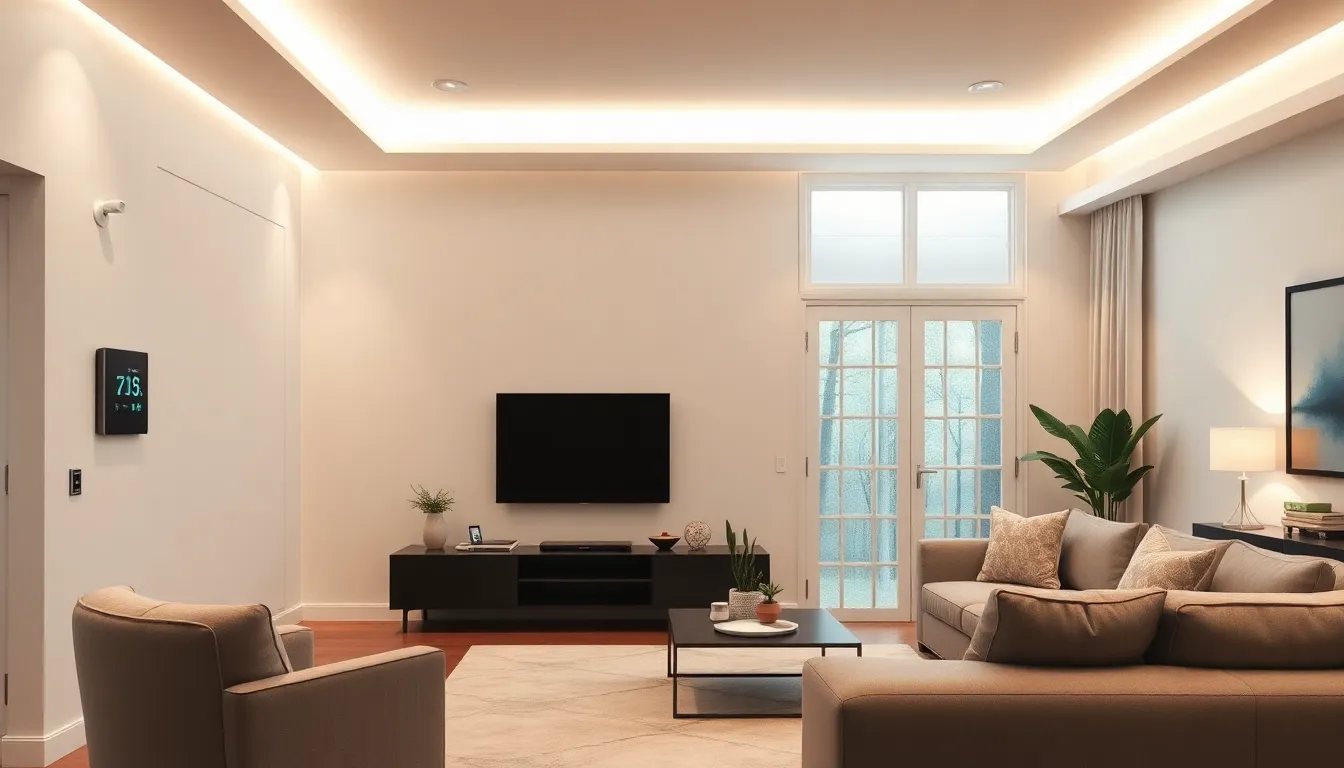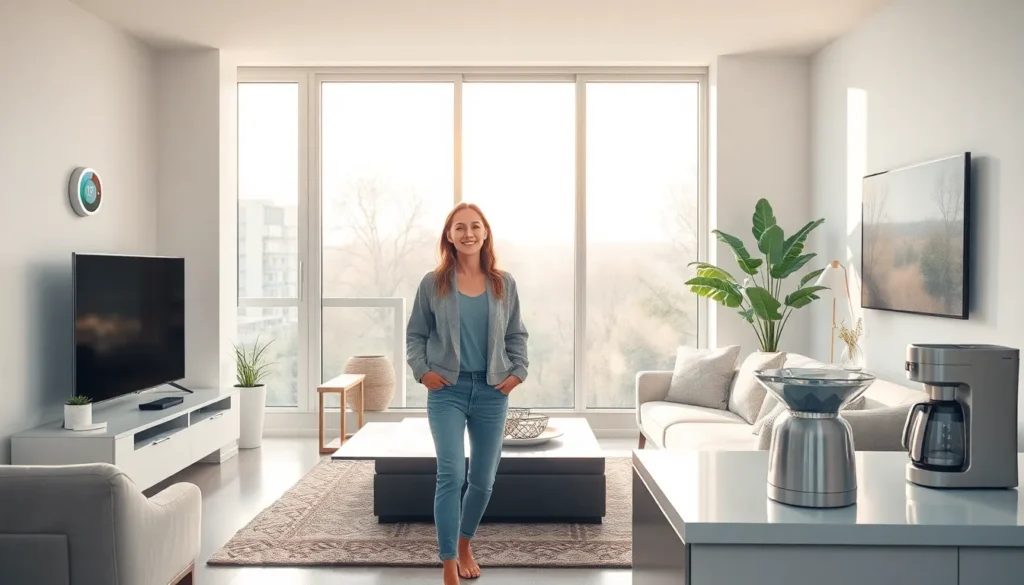Imagine walking into a home that knows you better than your best friend. Smart home design isn’t just a trend; it’s the future of living. With the click of a button—or a simple voice command—your lights dim, your coffee brews, and your thermostat adjusts to the perfect temperature. Who wouldn’t want a house that’s basically a personal assistant?
But smart home design goes beyond convenience; it’s about creating a space that reflects your lifestyle while saving energy and enhancing security. It’s like having a superhero for your home, swooping in to save the day—minus the cape and tights. As technology evolves, so do the possibilities for transforming any space into a smart sanctuary. Buckle up as we explore how to turn your living space into a tech-savvy haven that’s both stylish and functional.
Smart Home Design
Smart home design integrates technology to enhance daily living. Homeowners enjoy seamless control over various systems, from lighting to security. Enhanced convenience stands as one of the primary benefits of smart homes. Energy efficiency plays a crucial role as well, with smart devices reducing unnecessary consumption.
Various elements contribute to smart home environments. Automated lighting systems adjust brightness according to the time of day. Thermostats optimize heating and cooling based on occupancy patterns. Security systems, equipped with motion sensors and cameras, monitor properties in real-time.
Smart appliances also help simplify household tasks. Smart refrigerators offer inventory management and recipe suggestions. Coffee makers can brew at scheduled times, allowing for personalized morning routines. These technologies work together to create a coordinated living experience.
Another important aspect is integration. Smart home systems often link through a central hub, enabling users to control multiple devices from a single interface. Voice-activated assistants enhance interaction, providing convenience and accessibility.
Aesthetic design complements functionality. Homeowners can choose stylish devices that align with their interior decor. Well-designed smart solutions ensure technology blends seamlessly into living spaces, maintaining a sophisticated look.
Safety and security features also enhance peace of mind. Smart locks allow remote access control, ensuring properties remain secure. Homeowners can receive alerts about unusual activity, reinforcing a sense of safety.
Overall, smart home design reflects evolving lifestyles. By incorporating technology, individuals create personalized environments that cater to their needs and preferences. This innovative approach transforms traditional homes into modern, efficient, and secure living spaces.
Key Components of Smart Home Design

Smart home design incorporates various innovative systems that enhance functionality and ease of use. Focus on three essential elements: smart lighting solutions, automated climate control, and home security systems.
Smart Lighting Solutions
Smart lighting systems enable homeowners to adjust brightness and color using mobile devices or voice commands. Integration with motion sensors personalizes lighting based on occupancy. Energy-efficient LED bulbs contribute to reduced energy consumption while providing customizable ambiance. Options include programmable schedules that align with daily routines, ensuring lights activate or deactivate automatically at specified times. Smart lighting seamlessly merges functionality with aesthetic appeal, enhancing spaces without sacrificing style.
Automated Climate Control
Automated climate control systems allow for precise regulation of indoor temperatures. Programmable thermostats adjust heating and cooling based on user habits. Homeowners can control settings remotely, ensuring comfort upon arrival. Features include smart vents that optimize airflow based on room usage. Energy efficiency is a key benefit, reducing utility bills while maintaining an ideal living environment. Integration with other smart devices provides comprehensive climate management tailored to personal preferences.
Home Security Systems
Home security systems encompass smart locks, cameras, and motion detectors for enhanced safety. Real-time monitoring features allow homeowners to keep an eye on their property from anywhere. Mobile alerts notify users of unusual activity, ensuring swift responses to potential threats. Many systems integrate with existing smart home platforms for streamlined control. With features like remote access and two-way communication, peace of mind becomes a priority for residents, fostering a secure living space.
Benefits of Smart Home Design
Smart home design offers numerous advantages that transform living spaces into efficient and comfortable environments. Homeowners enjoy increased energy independence and enhanced functionality through advanced technology integration.
Increased Energy Efficiency
Smart home features enhance energy efficiency significantly. Automated systems optimize heating, cooling, and lighting. Homeowners can program thermostats to adjust temperatures based on occupancy patterns, thereby reducing energy consumption. Smart lighting systems use sensors to turn off lights in unoccupied rooms, preventing waste. Additionally, reports indicate that households utilizing smart technology observe energy savings of up to 30 percent. Such efficiency not only lowers utility bills but also contributes to environmental sustainability.
Enhanced Comfort and Convenience
Homeowners experience enhanced comfort and convenience through smart home design. Voice-activated assistants allow for effortless control of various systems, streamlining daily routines. Automated blinds adjust sunlight levels according to preferences, while smart coffee makers prepare brews right on schedule. Personalized settings create a living environment tailored to individual needs, improving overall quality of life. Statistics reveal that 60 percent of users experience increased satisfaction with their living spaces after incorporating smart technology. This transformative approach fosters an enjoyable and stress-free household.
Challenges in Smart Home Design
Smart home design presents various challenges that homeowners and designers face. Addressing these issues ensures a successful integration of smart technology.
Cost Considerations
Costs can escalate quickly in smart home design. Initial investments for smart gadgets, installation, and integration often require significant budgets. Devices like smart thermostats, security systems, and lighting solutions carry individual price tags, making it crucial to prioritize purchases based on needs. Homeowners can expect to invest anywhere from several hundred to several thousand dollars depending on the scope of enhancements. Additionally, ongoing expenses for maintenance and subscription services can impact long-term budgets. Understanding total costs upfront and budgeting effectively can help manage financial expectations while optimizing smart home features.
Integration with Existing Systems
Integrating smart home devices with existing systems poses another challenge. Compatibility issues often arise when adding new technology to older home systems. Many legacy devices do not sync with modern smart technologies, leading to disjointed functionality. Ensuring seamless integration requires careful planning and often the use of smart hubs or adapters. Homeowners should evaluate their current systems and determine which devices support connectivity, focusing on compatibility to avoid frustrations. Successful integration not only enhances user experience but also maintains the aesthetic cohesion of living spaces, which is a top priority in smart home design.
Future Trends in Smart Home Design
Smart home design continues to evolve, with trends focusing on enhanced integration and accessibility. Designers emphasize the importance of interoperability among devices, ensuring seamless connections between various systems. Artificial intelligence plays a crucial role, enabling smarter systems that learn homeowner preferences over time.
Sustainability gains momentum, with eco-friendly devices becoming a priority for many. Solar-powered appliances and energy-efficient systems significantly reduce carbon footprints and energy costs. Homeowners increasingly seek options that align with their values, leading architects to incorporate green technology into smart homes.
Voice control remains at the forefront, simplifying interaction with devices. Homeowners embrace voice assistants, which streamline tasks like adjusting lighting and controlling thermostats. Customization options for voice commands enable a more personalized experience, increasing user satisfaction.
Integration of visual technology is also on the rise, with smart mirrors and displays becoming common features. These devices provide real-time information, such as weather updates and news headlines, directly in living spaces. Intelligent displays enhance user engagement and enrich daily routines.
Furthermore, mental health considerations influence design elements, with spaces that promote well-being featuring prominently. Mood lighting and nature-inspired designs cultivate a calming environment, catering to modern lifestyle demands. Designers remain focused on creating smart homes that foster mental and emotional health.
Cybersecurity continues to be a chief concern as smart homes expand. Homeowners prioritize robust security measures, including two-factor authentication and encrypted connections. Manufacturers focus on enhancing protective features to build trust and ensure user safety.
These emerging trends in smart home design reflect a growing desire for efficiency, sustainability, and improved quality of life, as homeowners adapt to a technologically advanced future.
Conclusion
Smart home design is more than just a trend; it represents a shift towards more efficient and personalized living. By integrating technology into everyday life, homeowners can enjoy increased convenience and enhanced security while reducing energy consumption.
As trends evolve toward sustainability and improved accessibility, the future of smart homes looks promising. Homeowners are encouraged to embrace these innovations to create spaces that reflect their lifestyles and values.
With careful planning and consideration, the challenges of integration and cost can be navigated, resulting in a harmonious blend of style and functionality. Adopting smart home design not only enhances daily living but also paves the way for a more connected and sustainable future.


More Stories
Home Trends and Design: Transform Your Space with the Latest Stylish Innovations
Custom Home Design Services: Transform Your Dream Home into Reality Today
Studio41 Home Design Showroom: Transform Your Space with Exceptional Design Inspiration